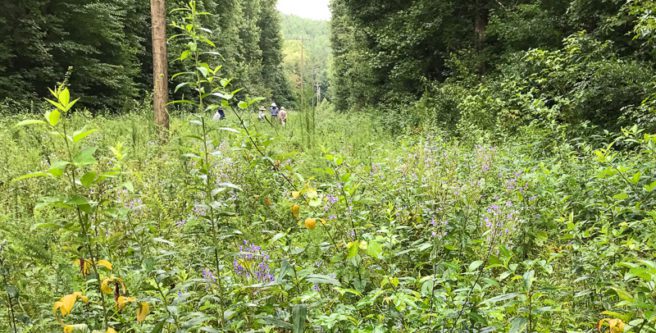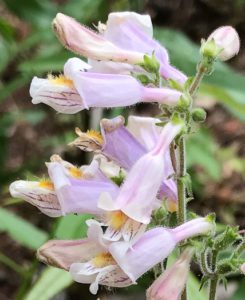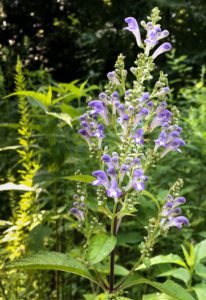It was around 2004 when my eyes caught a flash of blue in the vegetation of a powerline right-of-way. Steve and I were on the way to an impromptu picnic on the Middle Saluda River, and he is used to this: on the way home he pulled over and I clambered up the bank to investigate. My goodness. Blazing-star! — wonder what else is here?
And so it began…
Interestingly, country roadsides and utility rights-of-way can often be places of refuge (refugia) for native plants that cannot survive frequent mowing or thrive under a woodland canopy, plants that would have inhabited our almost forgotten Piedmont prairies. In times past, much of the Piedmont was covered by prairies, an ecosystem that is home to more rare and declining species, including grassland birds, than any other habitat in the Southeast, and is now itself endangered. To learn more, visit www.fws.gov/southeast/news/2020/02/new-videos-released-on-the-history-and-future-of-prairies-in-the-piedmont/
This was during the years that the Society was under contract with the US Forest Service to provide locally collected seeds of native grasses and wildflowers. I showed the site to Bill Stringer and he added it to our seed collection itinerary — not as a place to collect, but as a first stop, where he could introduce volunteers to many of the species that they were likely to encounter throughout the day, all within just a few yards. No doubt a real prairie would have had a higher complement of grasses and not so many blackberries, but even so the plants here were unusually diverse. We stopped other times as well, and every visit brought new discoveries.
Frank Holleman was along on one of those stops, and he coined the name “Janie’s prairie”. Frank is the President of Naturaland Trust, which had their eyes on about two miles of Middle Saluda River frontage that they hoped to be able to protect. In 2018 they closed on a large tract which includes this particular right-of-way, and Janie’s prairie is now protected!
Before the year was out, Rip and Kathy Harrington bush-hogged the open area, and the following year a group of us visited once a month with the lofty goal of identifying and recording every plant species within the ROW. A daunting task! Team member Gill Newberry, a retired botany professor who trained in the Midwest, pointed out to us that a prairie does not burst into bloom in spring. Rather, she said, it has vertical blooming strategy. Throughout the growing season there is always something blooming; there are always flowers floating above the sea of grass….
Thus in Spring, when the grass is just breaking dormancy, early flowers lie close to the warming ground. Both Little Sweet Betsy and Catesby’s Trillium occur here, along with May-apple, Green-and-gold, Blue-eyed Grass, and several species of violets.
Later, as the grass begins to stretch, the cast of characters changes. We watched as Hairy Phlox was replaced the next month by Carolina Phlox, and Robin’s Plantain gave way to its sister fleabane daisies.
May and June kicked off Summer with a grand display of Downy Beardtongue; July surprised us with a host of waist-high Hoary Skullcap, and then we started rolling into Fall. We saw a handful each of various sunflowers, goldenrods, asters, and (are you ready?) nine different species of beggar’s lice!
Naturaland Trust has plans to remove the stand of planted pines currently edging the ROW, to give the sun-loving grasses and forbs room to spread away from the powerline. This will also allow the use of prescribed fire for vegetation management.
The seedbank here is quite rich; I wonder what we’ll see after a burn? Just in the right-of-way and along the road, including the slender bit of woodlands between the two, we’ve already catalogued over 300 taxa! It’s been years, though, since we’ve seen Blazing-star.
— Janie Marlow
Naturaland Trust (www.naturalandtrust.org) is a nonprofit land trust that works to protect South Carolina’s Blue Ridge Mountains and special places in the Piedmont. When it went up for sale, Naturaland Trust acquired the 800-acre forest that incudes Janie’s Prairie, to protect it from development with the goal of ultimately conveying it to SC DNR to join DNR’s Tall Pines wildlife management area.
Plants mentioned in the article:
Chrysogonum virginianum Green-and-gold
Desmodium spp. Beggar’s Lice
Erigeron annua Fleabane Daisy
Erigeron pulchellus Robin’s Plantain
Erigeron strigosus Fleabane Daisy
Helianthus spp. Sunflower
Liatris spp. Blazing-star
Penstemon australis Downy Beardtongue
Phlox amoena Hairy Phlox
Phlox carolina Carolina Phlox
Podophyllum peltatum May-apple
Scutellaria incana Hoary Skullcap
Sericocarpus asteroides Toothed Whitetop Aster
Sisyrinchium angustifolium Atlantic Blue-eyed Grass
Solidago spp. Goldenrod
Symphyotrichum spp. Aster
Trillium catesbyi Catesby’s Trillium
Trillium cuneatum Little Sweet Betsy





